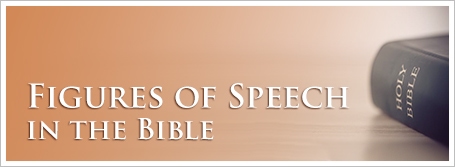As I was reading one of my favorite novels, set in Africa, my imagination was enthralled by the author’s description of the land and its people. I often stopped to highlight the phrases that brought me joy. In doing this, I was emphasizing the words that were important to me.
Well, did you know that God highlighted the Book that He authored? He did! When He wanted to emphasize something in the Bible, to give it special attention, He highlighted it, or marked it, with a figure of speech. A figure of speech is a word or sentence put in a form that is different from its literal or simplest meaning or use, adding strength, force, or intensified feeling. It arrests the readers’ attention and causes them to stop and consider what God is saying.
Every language has some basic elements: (1) the characters or letters that make up its alphabet, (2) words formed by those characters with specific and precise meanings, and (3) rules of grammar and syntax for how to put those words together. A figure of speech can deliberately depart from the normal meanings of words or from the usual syntax and grammar in order to add emphasis or increase the power of the expression.
As an example from the English language, we may tell someone who has supported us in a difficult situation, “You are my rock!” Now, of course, the person isn’t literally a solid mass of stony material but is being compared to the firmness and strength of a rock. This is figurative; the figure of speech is called metaphor—a comparison by representation. A more literal way to say this might be, “You provide me such firm and strong support!” But the expression “You are my rock!” increases the power of the sentiment; it adds force and intensified feeling. Let’s consider a few metaphors in the Bible that intensify the feeling of a passage:
- Rather than saying the Lord provides faithful, loving care for His people, the psalmist wrote, “The Lord is my shepherd…” (Psalms 23:1).
- To attribute the qualities of light and defense to God, Psalms 84:11 says, “For the Lord God is a sun and shield….”
- One metaphor that has been misunderstood as literal is in Matthew 26:26 when Jesus said in reference to the bread he gave to his disciples, “Take, eat; this is my body.” He was not literally telling them to eat his body. This is a metaphor meaning, “This bread represents my body.”
When we read a figure of speech in the Word, we can stop and consider what God is saying and emphasizing. This quote from Figures of Speech Used in the Bible, originally published in 1898, compares reading the Bible to a train ride:
It is as when we are travelling by railway. As long as everything proceeds according to the regulations we notice nothing; we sleep, or we read, or meditate as the case may be. But, let the train slacken its speed, or make an unexpected stop;—we immediately hear the question asked, “What is the matter?” “What are we stopping for?” We hear one window go down and then another: attention is thoroughly aroused, and interest excited. So it is exactly with our reading. As long as all proceeds smoothly and according to law we notice nothing. But suddenly there is a departure from some law, a deviation from the even course—an unlooked for change—our attention is attracted, and we at once give our mind to discover why the words have been used in a new form, what the particular force of the passage is, and why we are to put special emphasis on the fact stated or on the truth conveyed. In fact, it is not too much to say that, in the use of these figures, we have, as it were, the Holy Spirit’s own markings of our Bibles.
Let’s consider what God emphasized with a different figure of speech, polyptoton, a repetition of the same word in the same sense, but not in the same form.
Ephesians 6:18,19:
PRAYING always with all PRAYER and supplication in the Spirit, and watching thereunto with all perseverance and supplication for all saints;
And for me, that utterance may be given unto me, that I may open my mouth boldly, to make known the mystery of the gospel.
In verse 18 the verb “praying” is used with its cognate noun “prayer” to place great emphasis on the magnitude and gravity of praying always in the spirit for one another and the great results that will come from this earnest prayer.
II Timothy 4:6,7:
For I am now ready to be offered, and the time of my departure is at hand.
I have FOUGHT a good FIGHT, I have finished my course, I have kept the faith.
At the end of his life when Paul wrote, “I have fought a good fight,” the figure of speech is emphasizing the effort he made in the competition of life—that he had earnestly fought a good fight. We can stop and consider the truth that no matter what obstacle Paul faced, he stayed the course.
As you read the Bible, enjoy noticing figures of speech that arrest your attention and then stop to consider what God particularly emphasized in His Word. (Figures of Speech Used in the Bible by E. W. Bullinger is sold in The Way International Bookstore. It catalogs over two hundred types of figures of speech, providing a lifetime of study and reference for you.)

